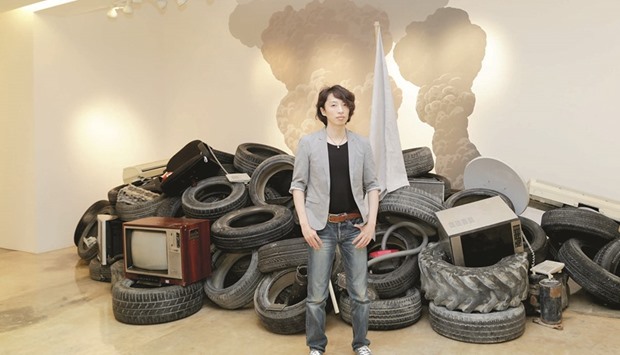In Masakatsu Sashie’s world, doom and danger are silent assassins. A devastated civilisation whimpers in ruins while an orb, an imaginary world representing large, city-like spheres made out of a random stash of multi-national brands and manmade objects, remains ominously suspended over it.
The prolific Japanese artist’s signature orb paintings of the “fictional world, filled with futuristic warnings about human’s tendencies for environmental dominance and over-consumption,” are as much a source for wide-eyed wonder as they are a trigger for a flood of questions, curiosities and concerns.
Talk to Sashie about his art and you immediately learn that the orbs were inevitable. “When I was younger, I wanted to draw the cosmos, but not just the cosmos,” Sashie tells Community, moments after the launch of his deeply compelling solo exhibition Micro Invasion at Anima Gallery, The Pearl, “I wanted to paint everything in one frame; my home, my neighbourhood, my region and the cosmos — all of these together. That’s where the quest for the orb paintings began.”
The gently-floating massive orbs are created out of scraps of old constructions from the Showa-period — a period of enlightened peace and harmony, period of radiant Japan during the time of reign of the Showa Emperor, Hirohito, from 1926 to 1989 — and pieces of mass production and mass consumption culture, says a note introducing the exhibition that opened last week and will be on until August 9. “Things like vending machines, pachinko parlours or fast food signs and video game components are woven into Masakatsu’s imagery in his orb painting,” the note points out.
Purely on aesthetics, Sashie’s paintings are exquisitely executed; the colour tones strangely soothing, the mood blending real and surreal, the look in sync with the panels of a deftly drawn post-apocalyptic graphic novel. Conceptually, Sashie achieves new heights by simply articulating what we all have silently pondered over many a time.
“As far as I can remember, I have always had this theme in my head,” Sashie says, referring to the orbs perpetually hovering over landscapes that are essentially landfills full of rolling hills of glowing televisions, tyres, vending machines, vehicles, and many such factory manufactured products, “But sometimes, when I might be angry or upset about something, I refrain from painting anything. That’s because it’s important that I have a clear, blank mind devoid of any dominant emotion when I create my art, so that I am able to express my idea through not just one facet, but all facets. I can’t afford to be imbalanced in my expression of thoughts.”
Art critics have found Sashie’s work to have a fantasy “old Japan” look about them, in the way he manages to mix elements of Japanese architecture from the post-World War II era with fantasy or science fiction motifs. The complete absence of human figures in Sashie’s work is also deliberate — he doesn’t want to give away a sense of time, space, or what direction or scale to think, on a platter to his viewer.
Over the years, Sashie has maintained what he has formulated as the fundamental theme of his work. “That theme is a ‘world’ that functions by the phenomenon seen in the balanced aquarium. It is a limited space within which the circle of life exists,” Sashie says, “The size of the world to an individual varies depending on his imagination and determination. How would one view the world if his living space were physically limited, maybe in a container, for example, an aquarium?”
“Every life form, within its designated space, occupies a smaller territory,” Sashie continues, “Within it, egoism and indifference toward the environment are repeated daily. Yet, it is also full of everyday tranquility and happiness. These two factors express a world, which is somewhat unstable but retains a comfortable balance.”
But why does he keep referencing corporate giants and their ubiquitous logos in his work? “The logos and signs of the big brands are like commercial symbols that have seeped so deep into our lives that we feel like these companies make our lives or are an integral part of it,” Sashie explains, “There are good parts and bad parts about this phenomenon of brands taking over our lives and I have tried to express both.”
One would be hard-pressed to see the good when, in Sashie’s work, multi-national companies revel in destruction and an ecosystem of exclusivity. Sashie, however, has an entirely different point of view. “But you see, destruction is a characteristic of nature. I don’t view it as bad. It’s not good, but it’s not bad either — it’s natural,” Sashie says, “So if the world is destroyed, it’s the will of nature. If you don’t want to see it get destroyed, you have to do something.”
Speaking of the artificial world of brands and superficial pleasures seem like the farthest one can be from nature. And again, Sashie surprises you by what he perceives as natural. In fact, he holds immense appreciation for manmade objects and finds beauty in the contours of disused machines and the monotony of their uniformity.
“I believe these brands and their products are part of nature,” Sashie declares, “All man-made objects are part of nature, as they are a natural extension of mankind, and a physical manifestation of man’s creativity. For instance, while petrol is derived from nature, we often think of it and treat it as artificial. I believe that everything we make is also nature because we are nature.”
Born in 1974 in Kanazawa, Japan, which is also where he currently lives, Sashie has imbibed the rich traditional art heritage of his city as much as he has attuned himself to its ever-rising contemporary art dynamics. Sashie’s work has been exhibited throughout Asia and the US including art fairs such as The Armory Show in New York and Art Hong Kong. In 2012, his work was included in the Giant Robot Biennale 3 exhibition at the Japanese American National Museum in Los Angeles, California.
As an influential artist who represents the Japanese flag around the world, Sashie doesn’t back away from even replacing the large red disc, representing the sun, in the centre of the Japanese flag, in his painting titled Fever. The red disc makes way for his favourite muse — an orb, either filled with pachinko units, vending machines or fast-food brands. “I wanted to show how the streets of Japan are so safe that the food and drink vending machines are so commonplace all across our cities. So while the contents of the orb speak about the safety in Japan, it also speaks of the American brands taking over our society,” he explains.
As art lovers of Doha admire and converse over the series of Sashie paintings that grace the bright white walls of the gallery, at one corner lies an art installation that’s basically a real world rendering of one of Sashie’s works — a rubble of car tyres strewn with broken home appliances, and a large grey flag perched on top of the heap. It seems like a call to action for mankind at large, a visual warning of what our greed has left us with.
“The flag is grey because grey has no meaning. So you can interpret this the way you wish,” Sashie says and smiles. It’s perhaps that spacious breathing room for boundless interpretation that Sashie’s clearly worrisome depiction of a near-dystopian future allows is what makes his work stay with you, long after you have left the venue.

MAKING A STATEMENT: Masakatsu Sashie at the exhibition in Anima Gallery.


